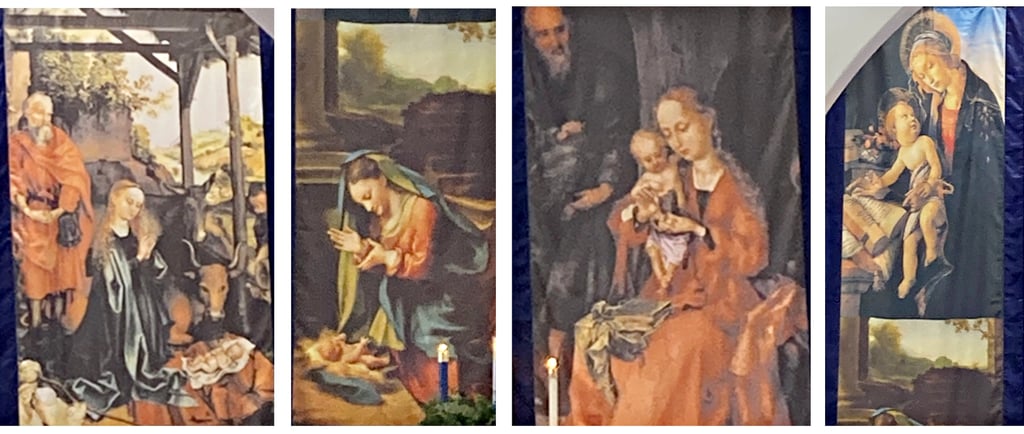THROUGH MARY'S EYES: FINDING MY MOTHERHOOD IN RENAISSANCE ART
ALM No.78, July 2025
ESSAYS


For years, I sat in the same pew, watching the advent altar panels cascade from ceiling to altar – four striking images of the Virgin Mary and Jesus. Then one Sunday, something shifted.
I no longer saw just sacred icons, but portraits of a mother's love - raw, human, and achingly familiar. These Renaissance masters had captured something I recognized from my own journey to motherhood through adoption, though it would take me years to fully understand the connection. My gaze moved from passive observation to active exploration, sparking a compelling curiosity about these four interconnected images.
Armed with just my iPhone and curiosity, I photographed the panels and turned to Google Images, determined to understand these powerful works that had awakened something deep within me. Through my research, I discovered how Renaissance masters Botticelli, Carracci, Schongauer, and Caravaggio revolutionized religious imagery by infusing divine subjects with raw human emotion. Their Madonna and Child paintings transcend traditional religious art, capturing universal experiences of love, protection, and devotion that speak directly to the heart.
In December 2004, my journey into motherhood began during Advent, a season of hope and anticipation. As I prepared for my ten-day adoption journey to China, each moment felt sacred, the proximity to Christmas adding deeper meaning to this profound new beginning.
During this time of waiting, I contemplated the unique beauty of adoption, finding parallels in the spirit of Advent - a season of anticipating something extraordinary. Each day brought me closer to the moment when my child would transform our family, making this holiday season unlike any other.
Now, twenty years later, each of these four Renaissance depictions of Mary's motherly love reveals something specific that deepens my own connection to both Mary and motherhood through the lens of my adoption journey.
Schongauer's "The Virgin and Child" depicts the Nativity in its humble setting - a moment that marks the beginning of a profound journey into motherhood. Like Mary's unexpected sacred space in a stable, each mother's path to parenthood finds its own unique sanctuary.
I wait in a stark hotel conference room in China. I'm about to become a mother. Surrounded by round tables and empty chairs, it is to be my sacred space. Different than I've imagined, yet perfect in its own way.
The others in my travel group of adoptive parents' Chinese adoptees have already become parents. Ten babies from an orphanage delivered. One more arrival is very late. Another orphanage is bringing a 28-month old girl.
Understandably the other new parents want to leave. I wave them off with smiles and gratitude for waiting so long with me. My excitement wanes. My worries escalate.
Two men enter, one holding tightly a large clutch wallet, the collector of the red envelope. The other holding the hand of a bright red cheeked, waddling toddler bundled in layers of clothing. I see her. I'm stunned. My future. Delivered in an orange fleece jacket with a cat face on the side, the attached hood is clearly a replica of a bear, another discard from one of the hundreds of clothing factories in China. The men greet Aisha the adoption agency director. There is clear consternation in the dialogue between Aisha and the two men. The scared toddler begins to shake followed by a wail.
In Correggio's painting, Mary's hands reach toward baby Jesus - a timeless symbol of a mother's protective gesture, that primal need to provide love and comfort. Heaven's pronouncement of motherhood echoes across centuries to my own moment.
My daughter is bellowing. A flash flood of motherly instincts pushes me toward my little bundle in her strange orange jacket. The word 'our' suddenly identifies me as I reach for my precious daughter.
The orphanage worker lifts her up, readying for the handoff. A photographer stands poised, smiling. I am so close now, brushing against my daughter, the 'Gotcha' moment a mere hand-to-hand exchange away.
Then another hand intrudes - a hotel assistant believing she can comfort the wailing child. Aisha screams at her. But no one can comfort this toddler. The crying will continue as she grieves a loss she cannot understand. Forever, that third hand will remain in my 'Gotcha Day' moment.
Perhaps there's always another hand in our mother-child love.
Carracci's depiction of Mary's gentle posture while holding baby Jesus beautifully conveys a mother's sense of patience and devotion. As she cradles him with exquisite tenderness, we see embodied the deep nurturing instincts that shape maternal love. In their shared gaze lies a profound understanding - mother and child connected in a sacred dance of patience and presence.
My own journey into motherhood would teach me that patience isn't just a virtue, but the very foundation of building trust and connection with a child. Through the translation and over terrified crying, I try to stay focused, but that's easier done on a yoga mat than in a real moment. The late orphanage workers were unprecedented I'm told.
It's 'Gotcha Day' for her crib mate too. I write their nicknames phonetically: Dahzwhang and Taow pi, my tin ear stumbling over Chinese pronunciation. Aisha laughs, nodding: 'Healthy,'
'Naughty.' Is my girl Healthy or Naughty? My child is Jian - healthy. That is good, I'm told. Taow pi was delivered first to her waiting future. Alone in the hotel room, I close my eyes. I know Jian, now Bailey, is watching me. In this lull between tears, she cannot see her future - only what she's lost: everyone and everything from the orphanage she's only known as home, even her mate.
I whisper 'Dahzwhang.' Her startled recognition of the mangled pronunciation is our first private connection. Then the wailing begins as she squirms across the big bed like a caterpillar. New orphans cry.
Bailey cries and screams for a week. No words. She will not look directly at me. Too much time has passed from womb security for her to expect comfort, kissing and eternal love. I will hold her and listen hour by hour to the 28 past months of pain and anger.
Botticelli's tender depiction of Jesus gazing at Mary captures a profound truth about the mother-child relationship - the fundamental power of presence. In the painting, Jesus's serene expression as he looks upon his mother suggests not just safety, but a deep recognition of being truly seen and understood. The sacred gaze between mother and child mirrors what we experience in our own mothering journeys.
On day nine I hear it. “Mama.”
Twenty years later, my daughter is a thriving, intelligent college student. Though the moments in her life I missed still ache within me. Many in the Chinese adoption community find comfort in an ancient proverb about an invisible red thread connecting destined souls.
In these cascading altar panels, in Mary's tender gaze, in her patient devotion, in her protective embrace, I see reflected not just my own journey to motherhood, but God's hand in bringing my daughter and me together.
Through these Renaissance masters' revelations, we discover a timeless truth – that motherhood, in all its forms, is a sacred communion of presence, patience, and profound love.
KB Cooper: With MFAs in Creative Non-Fiction and Dramaturgy, I work across multiple genres. I founded Travelingladies.net, an online community for mother-daughter and solo travel. My essays have appeared in Santa Monica Review and Harvard Ed Magazine. My recent work has earned literary recognition with award-winning short stories: "Do You Like Cake?" won the SCWC short story contest, and "Scared Bite" earned Writer's Advice's short fiction award. Two flash nonfiction memoir pieces have also been honored and published this year. "Pages of the Heart" will appear in the anthology And God Made Pets (July 2025).

